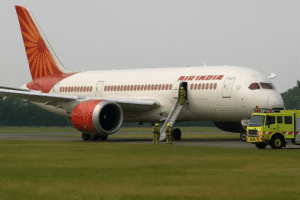Burning Smell Grounds Air India Flight: 5 Alarming Reasons This Incident Sparks Fresh Safety Fears
Air India flight AI639 from Mumbai to Chennai made a precautionary return shortly after takeoff on June 27th when crew detected a burning smell in the cabin. While the aircraft landed safely and passengers disembarked without incident, the event carries significant weight beyond the immediate disruption. This cautious response highlights vital aviation safety protocols prioritizing passenger well-being over schedules. However, it occurs under intense scrutiny following Air India’s tragic June 12th Ahmedabad crash and a string of recent technical incidents and emergency returns throughout June.
Though the safe landing demonstrates proper procedure, the repeated operational disruptions fuel passenger anxiety and erode trust in the airline’s reliability. The incident underscores the tension between necessary safety precautions and the growing perception of underlying maintenance or fleet management challenges Air India must urgently address to rebuild confidence. The lingering scent isn’t just smoke – it’s passenger unease demanding resolution.

Burning Smell Grounds Air India Flight: 5 Alarming Reasons This Incident Sparks Fresh Safety Fears
A routine flight from Mumbai to Chennai transformed into a stark reminder of aviation’s uncompromising safety protocols last Friday. Air India flight AI639, airborne and en route, abruptly turned back to its origin shortly after departure. The reason? A pervasive, unsettling smell – the distinct odour of something burning within the cabin.
While the aircraft landed safely in Mumbai without further incident and passengers were calmly disembarked, the event resonates far beyond a simple operational hiccup. It lands squarely amidst a period of intense scrutiny for the Tata Group-owned airline, raising questions not just about this flight, but about systemic operational resilience.
Beyond the Headline: Understanding the “Precautionary Return”
Air India’s swift confirmation highlighted the key term: “precautionary air-return.” This phrase is crucial. It signifies that while no visible fire, smoke, or immediate catastrophic failure was confirmed, the crew detected a potential threat serious enough to warrant abandoning the flight plan. A burning smell in an aircraft cabin triggers immediate, stringent protocols:
- Crew Vigilance: Flight attendants are trained to identify and report unusual odours instantly. Their senses are a critical first line of defence.
- Pilot Protocol: Upon such a report, pilots initiate emergency checklists, assess system readings, communicate with ground engineers, and make rapid risk assessments. Their primary mandate: passenger and crew safety above all else.
- The Conservative Choice: When the source or severity of an electrical or overheating smell is unclear, the safest action is to return. Continuing flight risks escalating an undetected problem at 30,000 feet.
In this instance, the system worked as designed. The crew identified the anomaly, the pilots exercised caution, the aircraft landed safely, and passengers were protected. Air India initiated an aircraft change, and ground staff provided support – standard, albeit disruptive, procedures.
The Shadow of June: A Context of Concern
However, the significance of AI639’s return cannot be divorced from its context:
- The Tragic Catalyst: The deadly crash of Air India Express flight IX171 in Ahmedabad on June 12th casts a long shadow. While investigations into that specific incident are ongoing, it has inevitably intensified focus on the airline’s overall operational health.
- A Pattern of Disruptions: June has seen multiple Air India and Air India Express flights reporting technical issues leading to diversions, delays, or returns. Just days before AI639, an Air India Express flight from Delhi to Jammu also returned to origin due to a technical snag. Another incident involved a Bangkok-bound flight held for hours in Mumbai.
- Heightened Scrutiny: Passengers, regulators, and the media are understandably hyper-aware. Each new incident, even a precautionary return handled correctly, amplifies concerns about maintenance practices, fleet reliability, and the sheer pressure of integrating and upgrading a historically underinvested airline.
The Human Insight: Trust, Anxiety, and the Cost of Caution
For the passengers on AI639, the experience was undoubtedly stressful. The smell of burning, however faint, triggers deep-seated fears. Their relief at a safe landing is tempered by the disruption – missed connections, appointments, and the lingering anxiety of “what if?” Air India’s ground support is essential, but it doesn’t erase the core unease.
This incident underscores a critical tension in modern aviation:
- The Reassurance of Precaution: The safe return is evidence of a safety system functioning. Pilots prioritized caution over schedule, demonstrating the industry’s core principle.
- The Erosion of Trust: Repeated incidents, especially following a major tragedy, chip away at passenger confidence. Each return, even justified, fuels narratives about reliability. Passengers wonder: “Is this just caution, or a symptom of deeper issues?”
- The Business Impact: Operational disruptions are costly – financially, reputationally, and in terms of passenger loyalty. Consistently smooth operations are paramount for rebuilding trust.
Looking Beyond the Incident
The burning smell on AI639 is likely traceable – perhaps an overheated air conditioning pack, an electrical unit, or burnt insulation. Engineers will diagnose it. The immediate safety response was correct.
The larger question for Air India, however, is how it navigates this period of intense operational pressure and public scrutiny. While precautionary returns demonstrate safety prioritization, their frequency suggests underlying challenges in fleet maintenance, technical reliability, or operational processes that need urgent and visible resolution.
Flight AI639’s U-turn wasn’t just about an odour; it was a demonstration of aviation’s safety-first ethos in action. Yet, it also landed on the tarmac of diminished public trust. For Air India, restoring confidence demands not only correctly handling individual incidents but demonstrably, consistently improving the foundation that prevents them from happening quite so often. The true test lies in ensuring the next headline isn’t about another mid-air concern, but about renewed operational excellence. The smell of caution was necessary; the airline now needs to eliminate the scent of uncertainty.
You must be logged in to post a comment.